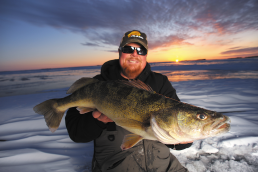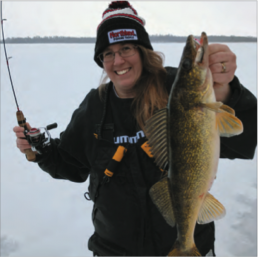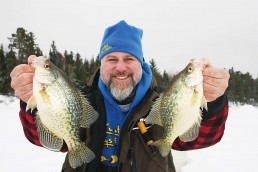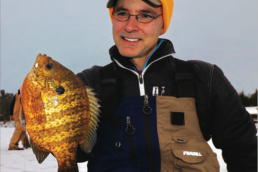First Ice, The Weeds Have ’Eyes’
SHARE THIS POST
By Brian “Bro” Brosdahl
November is a month of transition in northern Minnesota. The fall fishing is coming to an end, with the rifle deer season giving anglers something fun to do while they wait for the lakes to freeze.
There is little time to relax, with the Annual Bro Road Show beginning in mid November and continuing through the holidays and into early January.
People in Minnesota and throughout the Midwest love their deer hunting, but the focus quickly turns to ice fishing once the rifle deer hunting season is over.
Anglers in northern Minnesota and northeastern North Dakota have some of the earliest ice in the nation. There is usually walkable ice in several locations in late November, if anglers are willing to drive to the ice.
The Saint Paul Ice Show is the unofficial kick-off of the ice-fishing season. This year’s event is scheduled for the St. Paul River Center December 1-3.
Most of the pros attending the event want to have fresh photos from this year’s ice fishing to share with anglers attending the show. There is always a scramble to locate safe ice as early as possible, to get some decent fish photos before the Ice Show begins.
Brainstorming is always part of the process when trying to figure out where o go on early ice. Walleyes, perch and sunfish can all be caught on shoreline- connected flats with the right combination of weeds and structure
Finding good ice often means putting on some road miles to find the right lake that has enough ice and active fish along an accessible shoreline break. It sounds easy until you try to find locations that fit all the criterion.
Picking the right lake with the right kind of structure in front of the access is a big deal when it comes to having success on early ice.
My radar is always up when it comes to getting ready for ice fishing. I am constantly looking for ice-fishing spots, even when I am guiding during the summer.
I look for spots where I could walk out early in the year in front of every public access I fish with my boat. I have plenty of spots to fish once I am able to use a snowmobile, ATV or my truck to access the lakes, but finding spots where I can walk out and catch fish is more of a challenge.
Anglers walking out can capitalize on two different patterns for walleyes early in the season depending on whether the lake has stained water or clear water.
If the lake has stained water like Upper Red Lake and Lake of the Woods, then some fish usually are along the first break from shore. The key areas are often the turns, points or sections of the breakline with the sharpest and steepest drop-off into deep water. Patches of rock or gravel usually help the areas hold baitfish, which brings in the walleyes.
The other pattern on lakes with clear water are shoreline-connected flats with green standing weeds. The weeds can be cabbage, coontail or American milfoil or a mixture of the above. Hard bottom areas with some gravel and broken rock, chara- covered sand flats and areas with multiple kinds of standing weeds are usually better than areas with one bottom type and sparse weeds.
Are you enjoying this post?
You can be among the first to get the latest info on where to go, what to use and how to use it!
Most standing weeds in lakes with clear water have an inside edge between 5 and 6 feet deep, and an outside edge on the weeds in 10 to 14 feet of water, depending on water clarity.
One of the big fish locations for shallow walleyes is a hump or rise in the weed flats that are just a little shallower than the inside weed edge, providing a bald top surrounded by standing weeds.
Clumps of weeds with distinct edges also can be good, with either the inside edge or the outside edge of the weeds potential spots for walleyes. Northern pike, perch, bluegills and bass often use many of the same areas as the walleyes early in the ice fishing season.
I wear my Frabill I-Float jacket with the built-in set of spikes around the collar when walking out on early ice. Fishing with a buddy is also a good idea.
I like to use a wider spoon for walleyes when fishing in shallow water. Wide spoons get more movement out to the side of the hole when I work the lure. UV color and rattles are also good features in shallow-water spoons for walleyes.
I can’t wait to fish the Northland Glo-Shot Spoons after using the prototypes last winter with great success. The replaceable glow stick gives anglers more glow than would be possible with glow paint alone.
I also like the Buckshot Flutter spoon for shallow weed walleyes and also for walleyes in shallow stained water lakes.
I like to pump the spoons a couple of times with a medium-action 28- or 30-inch Frabill Bro Series rod. Too soft of a rod tip does not work jigging spoons properly.
I drop the rod tip towards the ice after a couple of sharp pumps on the rod to get the spoon to shoot out to the side of the hole. Then I bring the rod tip back to the spot where the lure is only a couple of inches off the bottom and let the spoon flutter back into the hole.
I repeat this action doing different numbers of pumps on the rod until I see a fish on sonar. The closing move is usually shaking the rod tip while moving the lure up and down ever so slightly.
Anglers need to work the lures aggressively higher in the water column for the fish to see the lures from a distance through the weeds and then develop a closing move to get the fish to bite once they get close to the lure.
I can usually tell how the fish are reacting to my lure by what I see on my Humminbird Ice Helix 7 G2. Sometimes it helps to use down viewing with my Aqua- Vu Micro 5 camera to see the actual fish when they get close to the lure and know exactly what they are doing.
I usually bring enough stuff with me that it helps to pull a Frabill Sentinel 1100 flip-over one-man house behind me to haul my stuff and give me a place to get out of the elements.
I look forward to seeing everyone at the St. Paul Ice Show or on the 2017 Bro Road Show coming to a town near you this winter.
MWO
MWO
SHARE THIS POST
Did you enjoy this post?
You can be among the first to get the latest info on where to go, what to use and how to use it!
MWO
We believe being outdoors is good. With more than 1,000 articles each year, MidWest Outdoors magazine is all about sharing outdoor experiences with you—where to go, what to use and how to use it… whether you’re close to home or on that trip of a lifetime.




